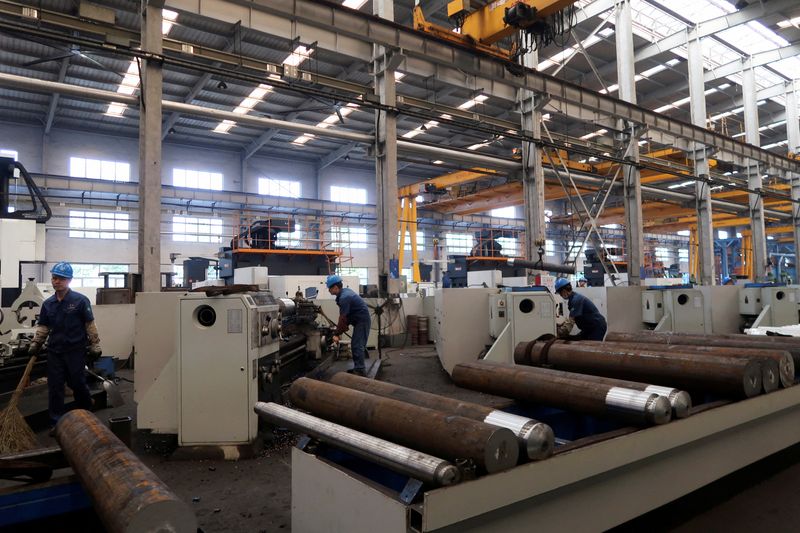By Jonathan Cable and Leika Kihara
LONDON/TOKYO (Reuters) -A downturn in euro zone manufacturing eased last month, suggesting the worst may be over for the bloc's beleaguered factories, while an unexpected rebound in China offered some hope for export-reliant economies, private surveys showed.
However, Europe's largest economy Germany remained a negative outlier among the continent's big players, and factory activity weakened in much of Asia as manufacturers there felt the pinch from rising input costs and slowing global demand.
Central banks have aggressively raised interest rates to rein in steep inflation but are likely at or nearing the end of tightening cycles as they await the feed-through and look to cushion the blow to their economies from sluggish global demand.
HCOB's final euro zone manufacturing Purchasing Managers' Index (PMI), compiled by S&P Global, rose to a three-month high of 43.5 in August from July's 42.7, albeit below a preliminary reading of 43.7. A reading below 50 marks a contraction in activity.
An index measuring output, which feeds into a composite PMI due on Tuesday and seen as a good gauge of economic health, rose to 43.4 from 42.7.
"We are now in a better position than many had anticipated given how high interest rates have risen and how quickly. But it is very uneven," said Craig Erlam at OANDA.
"It gives the European Central Bank pause for thought as they don't want to do too little on the inflation front but they also don't want to kill the economy."
Germany's manufacturing sector, which accounts for about a fifth of its economy, remained mired in a downturn on weak demand and rapidly falling output. In France, manufacturing contracted for a seventh month in a row.
In Britain, outside the European Union, factories suffered their weakest month since early in the COVID-19 crisis, with orders shrinking dramatically due to rising interest rates at home and abroad.
MIXED BAG
China's private Caixin/S&P Global manufacturing PMI rose to 51.0 in August from 49.2, beating analysts' forecasts and exceeding the 50.0 threshold.
The reading came a day after an official survey showed manufacturing activity contracted for a fifth month, offering a mixed picture on business conditions in the world's second-largest economy.
While the rebound in China's factory conditions could be a sign that official efforts to revive growth are starting to have some effect, manufacturing activity in most of Asia remained stagnant.
In Japan it shrank for a third straight month, while South Korea extended its longest-ever slump on wage pressures and soft exports, the surveys showed.
"It's unlikely we'll see a sharp, quick rebound in China's economy. With the outlook for advanced economies also uncertain, it's hard for Asian companies to be optimistic on the outlook," said Toru Nishihama, chief emerging market economist at Dai-ichi Life Research Institute.
"Stubborn food inflation is also hurting consumption in some Asian countries. The region's economy could be at a standstill."
Asia has been among the few bright spots in the global economy, though persistent weakness in China cloud the outlook.
In revised forecasts issued in July, the International Monetary Fund projects emerging Asia's economic growth will accelerate to 5.3% this year from 4.5% in 2022. It expects China's economy to expand 5.2% this year after a 3.0% increase in 2022.
Japan's final au Jibun Bank manufacturing PMI came in at 49.6 in August, unchanged from July and staying below breakeven for a third month, as input costs rose.

South Korea's PMI fell to 48.9 from 49.4, marking the 14th month of contraction on weak export orders.
Factory activity also contracted in Taiwan, Malaysia and the Philippines last month. India, by contrast, saw growth accelerate at the fastest pace in three months, driven by a strong expansion of new orders and output.